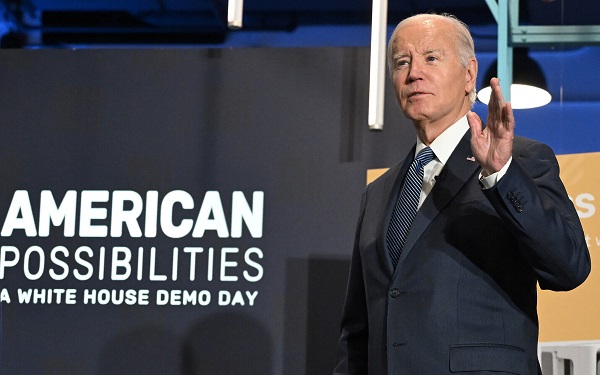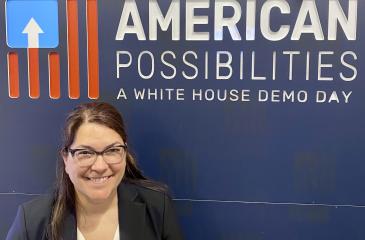Only a very small percentage of Americans will ever receive an invitation to a White House event where the President will be present. Tonya Rich, PhD, OTR/L, is one of the fortunate few.
Rich is an occupational therapist and rehabilitation scientist at the Minneapolis VA Medical Center who also has an appointment in the UMN Department of Rehabilitation Science. One of her research projects at the VA focuses on developing non-drug rehabilitation technologies for pain. In this project Rich is studying phantom limb pain, where people experience pain coming from a limb that no longer exists.
For some people, phantom limb pain will resolve within the first year after an amputation. But for others, it becomes persistent pain for which there are very few treatment options. Pain medications, including opioids, often don't work on this type of pain. And the challenge for non-drug treatments is that there isn’t a limb to rehabilitate.
Rich has worked closely with her clinician partners at the VA to develop a tablet-based treatment using what’s called graded motor imagery. This approach shows great promise for treating phantom limb pain – so much so that it landed Rich and a colleague one of 45 scientific demonstration spots at the White House Demo Day on November 7, 2023.
Event established under the Obama administration
White House Demo Day was established in 2015 as a way to showcase what federal research and development can accomplish. The event showcases inspirational and cutting-edge federal research and tools across a wide range of fields. This year’s audience included members of the media and more than 600 White House, Congressional, and federal agency staff, and President Biden.

“It's just such a rare opportunity to have a chance to go to something like that, and then to have a chance to have the President in the room was just like – I couldn't believe it,” said Rich. “All of a sudden this door opened and Secret Service walked in, and there's the President of the United States standing right there. It just was unbelievable. And to be a female scientist in that type of an environment was so fantastic.”
While President Biden didn’t view Rich’s demonstration, a lot of other people did – so many, in fact, that there was a line of people waiting to talk to Rich and her colleague, Kelly Yun, a research prosthesis designer who was demonstrating a technology for a prosthesis for improved footwear options. They had an opportunity to visit with several senior leaders from the VA.
“Many different people were there, including from the NIH, FDA, and other agencies,” said Rich. “The attendance was reported to be up to 700 people, giving us the opportunity to shine a light on our research where our approach is very unique.”
CTSI provided invaluable training and perspectives
Through her appointment in Rehabilitation Science, Rich was able to participate in the CTSI program Mothers Leading Science (MLS) and is an active member of the K Scholar Multidisciplinary Seminar Series. MLS is a CTSI leadership training program for research-intensive faculty in the health sciences who are raising school-age and/or young children. The program is designed to address the lack of representation of women in senior leadership, the high rates of attrition of female scientists, and the challenges of women in academic health sciences research at the intersections of career, gender, and motherhood.
“I participated in Mothers Leading Science, which I absolutely loved,” said Rich. “That has been really powerful for learning how to better advocate for the needs that I have and for the projects that I'm working on.”
Rich feels that the K Scholars weekly group meeting is a nice complement to MLS and helps to prepare a junior investigator.
“The topics that they cover are so well-curated that in my experience it just complements the mentor time I get with my subject matter experts,” said Rich. “And there's so many things that I've been able to bring over to the VA -- the types of things that I wouldn't have had without being involved in CTSI. It's non-duplicative of other mentoring I receive, and I've just found it to be really helpful.”
“The K Scholars group has reviewed my specific aims page more than once, and given phenomenal feedback and constructive critiques,” said Rich. “Sometimes you need someone who's totally out of your research realm to read something and give you feedback and let you know, ‘Yeah, this didn't sit with me,’ or ‘Maybe you could tweak this aspect.’ I found the CTSI programs to be incredibly supportive, and I feel very fortunate to be part of them.”
Like high-level brain trickery
Graded Motor Imagery is developed from the neuroscience research. An easy way to think about it is as retraining the brain through mental imagery and visual illusions which “trick” the brain.
“It’s like when you sit in a car and you've got your foot on the brake but the car next to you moves and then you feel like you're moving,” said Rich. “So that visual input overrides any rational thought you have in your body that your car is stopped. What we do is we try to give the brain visual input as though that limb is there and moving with comfort and with ease.”
Working closely with her amputation clinician partners at the Regional Amputation Center and the Rehabilitation & Engineering Center for Optimizing Veteran Engagement & Reintegration (RECOVER) at the Minneapolis VA, Rich has developed a technology that uses the camera function of a computer tablet and augmented reality to create a visual illusion of a limb. The app then provides audio instructions and walks the patient through different phases and treatments. Using the tablet technology, the patient can connect via Bluetooth to their hearing aid if they are wearing one.
The treatment begins by having people look at pictures and answer whether it’s a right limb or a left limb. Then they imagine movements, like they’re moving with comfort and ease in a preferred activity, maybe with a child or grandchild. The app then uses something called mirror therapy, where it generates a visual illusion, as though that limb is still there, and the brain receives that visual feedback.
Rich spent a lot of time developing a prototype. She recently received funding through a VA Rehabilitation Research & Development Career Development Award, a five-year award similar to a NIH K01 Career Development Award. Through this VA Career Development Award, she will refine the app and test it in a telehealth platform where she will have people doing the treatment at home and providing feedback on the feasibility and acceptability of the treatment.
While every person with amputation doesn’t develop ongoing, persistent phantom limb pain, for those that do this app shows great promise. There is a VA Amputation System of Care across the United States and there are different tiers of services in the clinics. Minneapolis is a regional amputation center where they have a comprehensive amputation team, fabrication processes, rehabilitation and all sorts of interventions.
“We're connected within the VA national Amputation System of Care,” said Rich. “As we're gaining traction on something and hope to get it translated to the field, we can tap into that national field, which is great. And we've gotten feedback from, for example, a group of Amputation Rehab Coordinators that I've already met with and shown a prototype of this. And they said, ‘Oh, I really like that feature!’ and ‘I don't like that feature’ and ‘What if it could do this?’ And that kind of information is just gold.”
More than two million people live with an amputation in the United States, according to the Amputee Coalition, and approximately 185,000 amputations occur every year. For those experiencing phantom limb pain, this app could be one tool in treating persistent pain to help restore their enjoyment of day-to-day activities.
